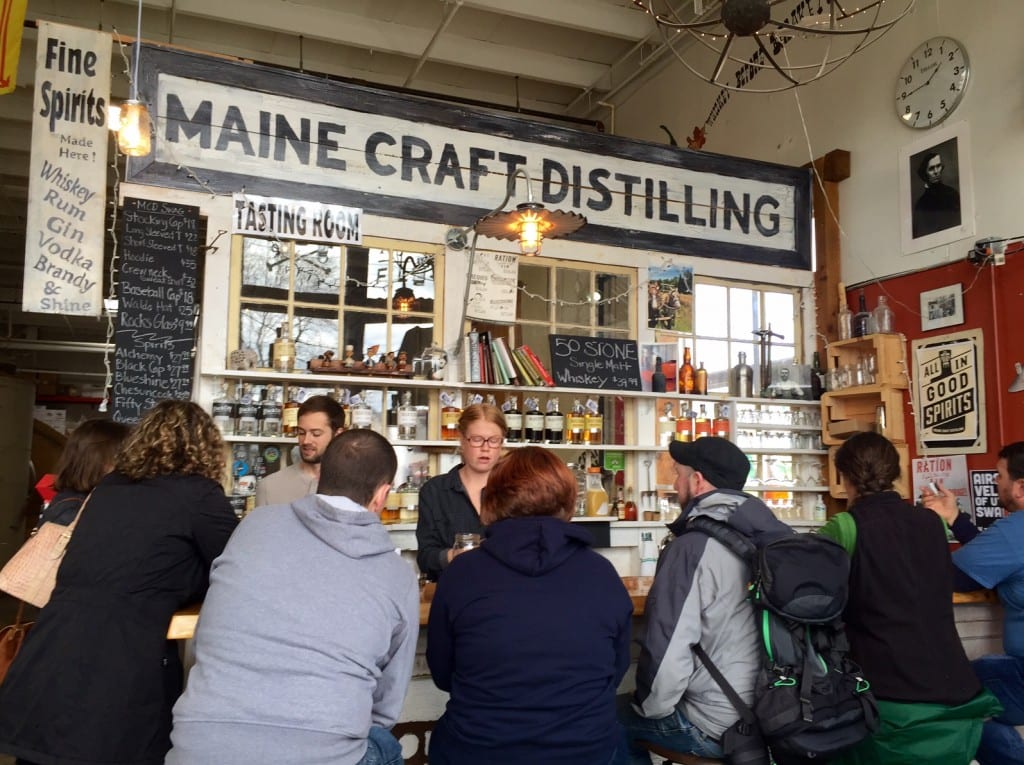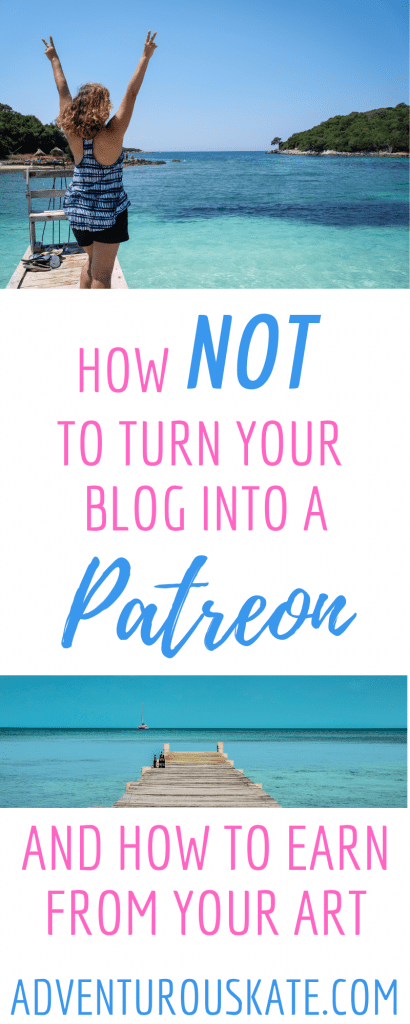Adventurous Kate contains affiliate links. If you make a purchase through these links, I will earn a commission at no extra cost to you. Thanks!
Starting my Patreon this year was one of the smartest business decisions I’ve ever made. In a time when COVID decimated the travel industry and I lost upwards of 90% of my income, it gave me a fun and fulfilling way to earn money and partially make up for what I had lost, while giving my readers exactly what they wanted.
How much money? Not enough to replace everything I had lost, but a significant amount — more than enough to live full-time in a cheap country — thus enough to help me sleep at night. And an amount that keeps increasing each month.
Patreon is an online platform where creators provide exclusive content to their biggest fans in exchange for a monthly subscription fee. It’s a way to make money direct from your readers, creating the kind of content they enjoy the most.
So many kinds of creators use Patreon. Podcasters and YouTubers use it for exclusive episodes; journalists use it for fascinating stories no publication would take. The Humans of New York guy makes an insane amount of money from Patreon, as does singer Amanda Palmer.
But best of all, Patreon is a platform that allows you to create art on your own terms. No sponsored content. No SEO. Just you and your art.
I’m happy to support a diverse list of creators on Patreon — a travel blogger, a writer, an embroidery artist, an artist in a variety of disciplines, and a journalist. I love their work and I love that I get to help support them.
As a personality-driven blogger, Patreon was a natural fit for me. Personal posts are my great love. I started writing more guide-type posts to earn money in the background, but I always make time to write fun posts that won’t earn anything, because that’s what you guys enjoy the most.
Turns out that Patreon is a way to actually get paid for those fun posts that don’t earn you anything.
There is so much potential for bloggers using Patreon — that is, if you do it right.
Note to all: this is a bit of an inside baseball post about how bloggers and creatives can make money with Patreon. No worries if you’re not interested — more travel content is coming up next week! But if you’re a creative yourself, I think you’ll enjoy this post.
Table of Contents
Patreon Mistakes
Patreon has been around for years, but the platform has been changing all the time. Even so, I’m surprised by the number of people who have potential to do it, but shy away from it. Fear of making a mistake could be part of it.
Here are the biggest mistakes I’ve seen bloggers make with Patreon:

Having a $1 tier.
This is probably the most common mistake I’ve seen happen on Patreon. I see creators launch their Patreons with a few different tiers — and the cheapest one is just $1 per month.
The key word here is “launch.” Because more than 50% of the time, the $1 tier is long gone within two months.
I understand why people initially have a $1 tier. It feels greedy to ask people for more than a dollar. It feels magnanimous to say, “Just one dollar per month!” It makes you feel like you’re being inclusive to your readers in developing countries like India and the Philippines.
But $1 per month is NOT much. And you don’t even see all of it! For transactions under $3, Patreon charges 5% plus $0.10, making a $1 pledge effectively just $0.85. You can’t even get a candy bar for that in the States. Considering the amount of work you do for it, it’s just not worth it.
Most people who sign up for your Patreon are going to sign up for the lowest tier available. Having a $1 tier could be the factor that earns you only $100 per month as opposed to $1000 per month.
Truth: To make sure you earn enough for your time investment, I recommend having your pledges start no lower than $5.

Assuming all your readers are broke at the moment.
We are going through the greatest economic catastrophe of our lifetime right now. Chances are we haven’t seen the worst of it yet in some industries, and it’s possible we will be feeling the effects for years. Unemployment levels in the US are unprecedented. That’s something you can never forget about.
BUT. Just because lots of people are taking a financial hit, it doesn’t mean everyone is taking a financial hit.
Lots of people are doing just fine financially — they’ve kept their jobs; their expenses haven’t increased; they’re watching their stocks recover. In fact, most of these people have MORE money than usual right now because they’re not spending it on bars, dining out, and international travel.
A lot of your readers who haven’t been financially impacted by COVID will be eager to support you on Patreon for a few dollars each month, especially if your industry has hit hard times. In fact, some of them will be eager to contribute the maximum.
Truth: Don’t assume that nobody has money to support your Patreon right now, because lots of people do and will be happy to.

Biting off more than you can chew.
It’s a good idea to have a high-end tier with some bigger, rarer, or customizable products. I’m offering 30-minute calls every other month in my $25 tier.
However, a tier with a lot of benefits can quickly snowball into a large pile of work — especially if you’re giving away one-on-one time or creating customized artwork, as many artists and poets on Patreon do.
But since I started doing regular calls with readers earlier this year, I learned that they’re a lot of fun but very draining for me energy-wise. So I limited the number of that tier to the number of calls that wouldn’t exhaust me each month.
I know a few creators on Patreon who overshot their top tier benefits and had to pull back a few months in.
It’s good to keep in mind how scalable your reward is, or how easily you can duplicate it for others without making much more of an effort for each individual. Some examples of scalable products are digital products and group calls. One-on-one calls are far less scalable, so they’re best to do for higher paying tiers.
Truth: Choose benefits that won’t be too onerous to fulfill every month.

Treating your Patreon like a charity rather than a product.
When I interviewed lots of bloggers who turned their blogs into Patreons, most of them talked about their hesitancy of asking their readers to support them. A lot of people used the word “handout” when describing the last thing they wanted.
That is not true at all. It might be true if you were soliciting general donations — but you’re not. Patreon is not a charity. It’s simply a product that you offer in exchange for money. People can choose to buy it if they want it.
Additionally, there are some bloggers who inadvertently treat their Patreon like a charity — they don’t create a content plan and just name their tiers “You Love Me” for $5, “You Really Love Me” for $10, and “You Really Really Love Me” for $25. There are no differences in the deliverables; it’s just collecting different amounts of money for the same nebulous product.
You might get a few big fans or your grandmother to sign up for that. But it will put off other readers.
Treat it like a professional product and people will respect it.
Truth: Patreon is not charity; it is another product that you can offer your readers.

Not understanding the kind of content your fans want.
One of the most important things you can do as a content creator is to survey your readers — every year if you can. Not only does it provide detailed demographic data on your readership, it also tells you the kind of content your readers enjoy the most.
(How do you survey your readers? I recommend SurveyMonkey; you can use Google Forms for free if you don’t mind it being a bit more DIY.)
Surveying readers taught me that my readers’ favorite posts are my monthly recaps, my personal posts, and my long-form creative posts. They love stories; a lot of them love my book reviews. They don’t come to the site for information-based, SEO-driven travel listicles (though once they plan a trip, they always check to see if I’ve written about their destination, no matter what kind of posts there are).
Because of that, I’ve made long-form original posts the cornerstone of the Patreon content I create. Each month, you get one original long-form story. There are lots of other benefits — a Facebook group, free access to book club meetings, monthly videos and calls, lots of shorter stories — but that long-form story is the main attraction.
A few of the bloggers I spoke to admitted they made missteps early in their Patreon journey. They concentrated on making factual resources the essence of what they provided on Patreon. But that’s not what their patrons wanted. They wanted more personal content. They were supporting the creators in the first place because they liked who they were as people.
So much of Patreon is personal. Don’t forget that.
Truth: Don’t choose your content for Patreon until you know exactly what your readers want.

Not charging patrons at the time of purchase.
In the Patreon dashboard, it gives you the option of charging patrons immediately or waiting to charge them until the first of the the month. You should tick the button that charges them immediately.
Why? I’ve heard of some cases where people signed up, spent a few days going through the content for free, and then canceled their membership without ever being charged.
People will do that. But at least you’ll earn some money this way.
Truth: Always set your Patreon up to charge upon sign-up.

Pushing for new patrons near the end of the month.
Once people sign up, they will be charged on the first of the month, no matter when they sign up. That can be a bit annoying.
I feel bad about people who sign up on, say, the 27th of the month, then get a second charge a few days later.
There will be people who sign up late in the month. It’s impossible to prevent that. But you can minimize this by doing your promotion earlier in the month.
Truth: Do your heavy Patreon promotion in the first two half of the month to keep people from being charged twice within a short time span.

Not promoting Patreon on other forums.
Ah, the art of self-promotion. Until you get used to self-promotion, it feels awkward as hell — but if you’re a blogger by now, you’ve learned over time how to finesse it better than most people.
You can’t just start a Patreon, set it and forget it. You need to keep reminding people that it exists. Whenever I produce something particularly good on Patreon, I casually mention it on social media or in my newsletter or in my monthly recap, and sometimes that’s all it takes. Make it sound awesome and people will be intrigued.
Another hard truth is that no matter how good your Patreon content is or how much your readers love you, some people are going to drop out over time. Try not to let it hurt when they unsubscribe.
Truth: You need to keep promoting Patreon regularly in order to keep your income levels up.

Assuming that Patreon is passive income.
Patreon is not passive income any more than blogging is passive income. By that, I mean that Patreon is scalable in some aspects — the same amount of work could net you $200 per month or $2000 per month — but doing the work itself takes a lot of time and effort.
But just how much of blogging is actually passive these days? Yes, you have to do a lot of work, but the more people you bring in, the more money it makes. Patreon is the same way.
Truth: If you’re looking for purely passive income, Patreon is not the way to go about it. But if you’re looking for scalable income, Patreon could be for you.

Giving up.
Yeah, people give up on their Patreons. Which isn’t a huge surprise. If you don’t have a specific framework to start it and keep going, it’s going to be hard to keep going.
But cut yourself some slack! This is a completely new platform for you. It takes time to figure out what works for you.
As time goes on, I’m learning a lot about what works and doesn’t work in my own Patreon. On my first call, I realized that simply having an AMA isn’t enough, that I need to have specific discussion where I want to take people. Now, I’m getting ready to add a new benefit to my $10 tier based on downloadable content. It’s always a work-in-progress.
Truth: You will hit hard times with Patreon at some point. Don’t give up. It will get better.

Assuming that Patreon’s benefits are solely monetary.
Sure, creators start Patreons because they want to make more money. And after losing my income due to the travel industry’s implosion post-COVID, that money saved me and continues to save me each month! But what has surprised me the most has been the relationships I’ve cultivated.
Through Patreon I’ve gotten to know many of my readers personally. Some of them have been reading me for 10 years. They are amazing people and I love getting to know them. I feel like I have an inner circle for the first time ever!
Another plus about Patreon is that it’s often the work that you enjoy the most, the work that fulfills you. (Usually your readers can tell when you really enjoy writing a piece, and it pays off.) One of my journalist friends told me that she’d be happy to earn less per hour from Patreon than she would from a publication, because it would be fun, fulfilling work with full creative control, no ads, no sponsored content, no editor to please.
Truth: You might be shocked at how Patreon fulfills you emotionally — and that’s before you factor in the money you’re earning.

What should you offer on Patreon?
Are you thinking about starting a Patreon? You should! The next step is to brainstorm what kind of rewards would work best for your audience.
I created a free PDF that shows 18 different products to offer people on Patreon — types of exclusive content you can create, different methods of access to offer, and six outstanding high-ticket offers for your higher pledge amounts.
And that’s just the beginning. I will be sharing some more Patreon information on that mailing list that I will be keeping private from the blog, so if you’re interested in more free information, I will be sending it from there.
I hope this helps you earn from your creativity! And if you need any inspiration, check out the Adventurous Kate Patreon here.

Have you considered starting a Patreon? Share away!